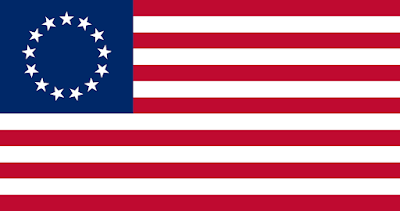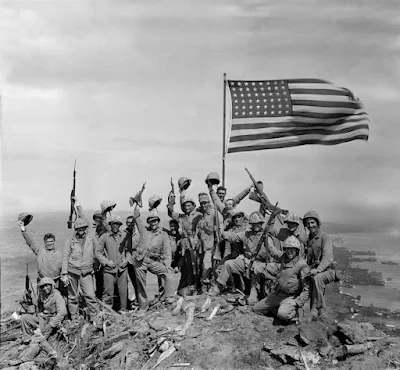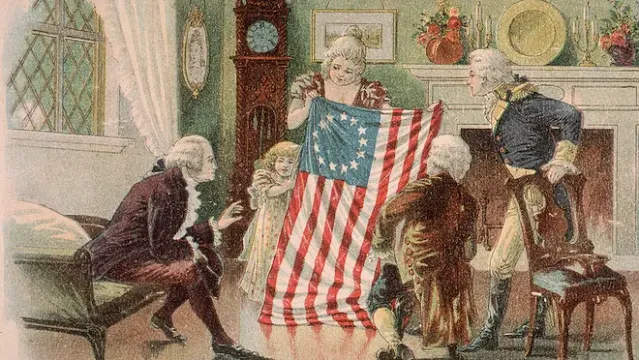The 14th day of June is U.S. Flag Day here in the United States of America.
This day commemorates the adoption of the first official flag used by the original thirteen American States following their declaration of independence from the authority of the British Empire by the Second Continental Congress in Philadelphia, Pennsylvania on Saturday, June 14, 1777.
Many Americans have only known one flag their whole lives -- the current U.S. Flag that became official on July 4, 1960, after the State of Hawaii was admitted to the Union as the 50th state in 1959. But for generations, the United States flag was an ever-evolving symbol that reflected the growth of the nation.
Throughout more than 245 years of American history, the United States flag (also more affectionately known as "Old Glory") has undergone near-constant transformation from the pre-independence Grand Union Flag to the 50 Star U.S. flag that many of my generation have known our whole lives today.
In point of fact, the U.S. flag has been officially modified from its original design approximately 26 times since 1777. The current flag, adopted by the U.S Congress on Saturday, July 4, 1960, is the 27th and the longest used version of the flag of the United States to date.
The following is a brief, but I hope informative, history of the flag of the United States of America.
Oh, before I continue, here is a chart explaining the vexillology terms for the parts of a U.S. flag in order to help you, the reader, follow along if you're unfamiliar with certain terms.
The Early Flags Of The American Revolutionary War
One such flag is the famous Taunton Flag, also known as the Liberty And Union Flag.
 |
| The Taunton Flag (also known as the Liberty and Union Flag) 1774, was one of the first American Revolutionary War flags. |
Adopted on Friday, October 21, 1774 -- just over six months before the first shots of the war would be fired at Lexington and Concord -- the Taunton Flag was raised on a tall pole outside the town's courthouse after the local Sons of Liberty had forced out most of the American Loyalists from the town of Taunton, Massachusetts.
The red flag had the British Union Jack banner of red and white St. George's Cross of England and the blue and white St. Andrews Cross of Scotland (also known as the "Kings Colours") as its canton and reportedly the words Liberty And Union painted across the red field -- although this latter fact is disputed when it comes to accounts of the original flag itself.
The Taunton Flag was one of the first flags used within the Thirteen Colonies to express dissension against the authority of the Crown. Ironically, the flag is still in use today as the official city banner of Taunton.
When the American Revolutionary War (1775-1783) formally broke out in spring of 1775, various banners of all types were used by the Colonials and Patriot militias, some of which bore no British symbol at all, opting for distinctly independent American banners such as the Taunton Flag, or the George Rex Flag in New York.
Perhaps the most famous of these Patriot banners are the "Don't Tread On Me" timber rattlesnake flags inspired by Benjamin Franklin's famous "Join, Or Die" political cartoon original published in his newspaper The Pennsylvania Gazette in 1754 -- the earliest known pictorial representation of a colonial union. The timber rattlesnake, being a distinctly American animal, became the first national symbol of unity and were widely popular among those Americans who began to see themselves as individuals independent from British authority.
Among these uniquely American rattlesnake flags are the white "Liberty Or Death" Culpeper Minutemen Flag and the distinctively yellow Gadsden Flag -- one of the first banners of what would later become the U.S. Marine Corps.
Colonel Christopher Gadsden represented his home State of South Carolina and was one of seven members of the Marine Committee outfitting the first American naval mission in December of 1775. The flag he designed was flown from the flagship and another copy of it was later presented to the South Carolina State Congress in February of 1776.
The Gadsden Flag remains one of the most popular historic banners of the American Revolutionary War.
 |
| The Culpeper Minutemen Flag 1775-1776. |
 |
| The Gadsden Flag 1775-1776. |
The Grand Union Flag & The Stars and Stripes Flag
It was decided that a new flag was needed to represent the Continental Congress and the United Thirteen Colonies with a banner distinct from the British Red Ensign flown from civilian and merchant vessels, the White Ensign of the British Royal Navy, and the Flag of Great Britain carried on land by the British army.
Americans first hoisted the Grand Union Flag on the colonial warship Alfred, in the harbor on the Delaware River at Philadelphia, Pennsylvania on Sunday, December 3, 1775, by then Lieutenant John Paul Jones of the newly established Continental Navy. The event had been documented in letters to Congress and in eyewitness accounts.
 |
| The Grand Union Flag of the Continental Army 1776-1777. |
The Grand Union Flag bore the Union Jack of Great Britain as its canton, but also bore the now familiar 13 red and white stripes representing the thirteen American States. The stripes were based on other banners used by organizations like the Sons of Liberty years before in their calls for American independence. An interesting compromise between loyalty to the Mother County and the idea of American sovereignty.
Its unknown who actually designed the banner, but the original Grand Union Flag that was flown on the Alfred has been credited to Philadelphia milliner Miss Margaret Manny as the original designer. Pennsylvania seamstress Miss Rebecca Flower Young was also credited with sewing other flags for the Continental Army and Navy during the war, including the first Grand Union Flag that was flown over Washington's headquarters.
It was under the Grand Union Flag that the American Declaration of Independence was signed by the Continental Congress in Philadelphia on Thursday, July 4, 1776.
The Grand Union Flag and would actually remain the symbol of American defiance to the British Crown until at least 11 months after the Declaration of Independence was signed. By this time though any affection to the Old World was largely severed -- at least by American Patriots -- and a new distinctly American flag was needed.
The Flag Resolution (Flag Act of 1777) formally passed by the Second Continental Congress on June 14, 1777 and seeking to promote national pride and unity, stated: "Resolved, That the flag of the thirteen United States be thirteen stripes, alternate red and white; that the union be thirteen stars, white in a blue field, representing a new constellation."
Following the resolution, the Grand Union Flag with its British Union Jack canton was permanently retired and replaced with a new flag that symbolized the independence and sovereignty of thirteen American States. This would be the first American flag to be known as the Stars and Stripes.
 |
| The original 13-Star Stars & Stripes Flag of the United States (1777-1794). |
Because the Flag Resolution of 1777 only specified 13 stars on a blue field and 13 stripes of red and white, initially there was little regulation to the design of the U.S. flag. The resolution at the time did not specify the pattern for the stars, the number of points on the stars, the width of the stripes or the canton (the blue field), or whether a white or red stripe should be first.
Flag makers often improvised on patterns and the number of points in the stars. Sometimes even the alternating 13-stripe arrangement was open to interpretation. This caused a proliferation of flag designs with the stars especially being in many different patterns.
Perhaps the most famous variant of this flag was allegedly designed by Philadelphia upholsterer and flag maker Miss Betsy Griscom Ross (1752–1836), the new banner of Washington's Continental Army had 13 five-pointed white stars arrayed in a circle on a blue canton (union) with 13 horizontal red and white stripes.
The story of this flag comes entirely from Betsy's grandson William J. Canby, and a few other relatives, all of whom stated many years after her death that they heard Betsy tell the story from her own mouth. Canby told this story in 1870, around the time of the upcoming Centennial celebrations and the family legend became a part of the American consciousness.
The legend goes that George Washington, George Ross (the uncle of Betsy's late husband and a member of Congress), and Robert Morris approached her secretly in May or June of 1776 and asked her to make the flag, however only circumstantial evidence supports the story. Betsy and George Washington sat in pews next to each other at church and Washington was known to visit Betsy socially and professionally, using her tailoring services.
Today the Betsy Ross Flag is largely used to commemorate U.S. Independence Day (July 4th).
 |
| The Betsy Ross Flag is considered one of the most iconic flags of American Independence. |
The Flag Act of 1794 -- The Star-Spangled Banner
Following the end of the American Revolutionary War and the establishment of the Federal Union with the ratification of the United States Constitution in 1787, the newly independent American States were now a new and growing nation.
In January of 1794, the U.S. Congress passed a second flag act to accommodate the admission of the States of Vermont and Kentucky into the Union later that year.
The Flag Act of 1794 reads: "An Act making an alteration in the Flag of the United States. Be in enacted by the Senate and House of Representatives of the United States of America in Congress Assembled, That from and after the first day of May, Anno Domini, one thousand seven hundred and ninety-five, the flag of the United States, be fifteen stripes alternate red and white. That the Union be fifteen stars, white on a blue field."
The act was signed into law by President George Washington in New York City, New York on Monday, January 15, 1794.
.svg.png) |
| The 15-Star Flag of the United States of America -- The Star-Spangled Banner. |
The 15-Star U.S. Flag is probably one of the most iconic designs after the famous Betsy Ross flag for its role during the War of 1812 during the Battle of Baltimore (September 12-15, 1815) when it flew over Fort McHenry and its presence inspired Francis Scott Key (1779-1843) to pen the poem that would later become The Star-Spangled Banner, the national anthem of the United States.
Mary Young Pickersgill (1776-1857), the daughter of Rebecca Young (mentioned earlier as one of the possible designers of the Grand Union Flag), was commissioned by the commander of Fort McHenry, Major George Armistead the year before the British attack. She and several others made the flag of 15 stars and stripes at her house and finished on the floor of a nearby brewery. A more detailed account of this story can be read at this blog site HERE.
The 15-Star U.S. Flag would serve from 1795 until 1918. It would be the only official flag of the United States to ever have more than thirteen stripes. As the result of the lack of a Flag Act between 1794 and 1818, there were no official U.S. flags with sixteen, seventeen, eighteen, or nineteen stars. No flag laws were enacted to accompany the admission of new states to the federal Union during this period.
The Flag Act of 1818 -- Setting The Standard
It also added five stars for the recently inducted States of Tennessee, Ohio, Louisiana, Indiana, and Mississippi into the Union, and also set the rule that provided for subsequent future changes in the number of stars for further States admitted to the Union be made on Independence Day (July 4th).
The Flag Act of 1818 reads:
"An Act to establish the flag of the United States.
"Be it enacted by the Senate and House of Representatives of the United States of America, in Congress Assembled, That from and after the fourth day of July next, the flag of the United States be thirteen horizontal stripes, alternate red and white: that the union be twenty stars, white in a blue field.
"And be it further enacted, That on the admission of every new
state into the Union, one star be added to the union of the flag; and
that such addition shall take effect of the fourth day of July then next
succeeding such admission."
A strange contradiction would happen in the period referred to as the American Civil War (or War Between the States) between 1861-1865.
During this time thirteen American States from the Southern United States withdrew from the Union (two of these -- Missouri and Kentucky -- had two separate State governments which represented congress in two American republics) and became part of the short-lived Confederate States of America.
Since the U.S. Congress and government refused to formally recognize the secession and independence of those "rebel states" or the Confederate government, the flag of the United States continued to have at least 13 trouble stars in its canton for the duration of that unfortunate and ugly war. In fact, between 1861 and 1865, there would be three more stars added to the Union -- including a new State of West Virginia which seceded from the then Confederate State of Virginia -- going from 34 to 36 stars in those years.
One of the controversies here is the fact that at least ten of the former Confederate States had to be readmitted to the Union over the course of several years following the end of the war, despite the fact that (at least according to the U.S. government) none of then actually left and no stars representing those states were removed from the flag itself.
The Confederate States Flag also has a rather interesting history and evolution similar to that of the Stars and Stripes that I'd previously discussed in an article on the origins of Confederate Flag Day (March 4th) which you can refer to for further information on the subject.
Another strange occurrence with the stars of the U.S. Flag in this time was the arrangement of the stars in the canton itself.
With every new batch of States added, the stars had to be rearranged into rows, but sometimes these would end up uneven and had to be arranged into other patterns like stars, circles, and diamond-shaped patterns that gave it a crab-like appearance.
One variation of this was called the "Great Star" U.S. Flag which consisted of the stars in the canton shaped like a large five-pointed star. This variation would be popular from the passing of the Flag Act of 1818 till sometime in the 1870s.
 |
| A variation of the "Great Star" pattern of the U.S.Flag popular from 1818 till the 1870s. |
Between 1912 till 1959, Old Glory had six even rows of eight stars in its canton, each representing the forty-eight continental U.S. States. This version of the U.S. Flag would serve as the second-longest serving design of the Stars and Stripes. It would serve as the national flag of the United States through both world wars and be featured in some of the most patriotic moments of that generation, such as the iconic raising of Old Glory on Iwo Jima on Friday, February 23, 1945 near the end of the Pacific Theater of World War II.
 |
| United States Marines on Iwo Jima following the battle to capture the island in 1945 beneath the 48-Star U.S. Flag. (Photo courtesy of the National Archives) |
This is the longest serving version of the Stars and Stripes to date. It was carried by American soldiers in the wars that have shaped the world we live in today -- for better or worse -- and was the first human flag to be planted on the surface of the Moon on Monday, July 21, 1969. It's the flag that has seen many of this country's greatest accomplishments of the last 60 years.
Most importantly to me, its the flag I served under as a U.S. military serviceman, which I continue to fly daily in front of my home. It is the flag that I proudly call the banner of my country.
Happy U.S. Flag Day everyone! God Bless America.
 |
| The Flag of the United States of America, also known more fondly by U.S. citizens as the "Stars and Stripes" and "Old Glory". |
The Pledge of Allegiance to the U.S. Flag:
"I pledge allegiance to the flag of the United States of America, and to the republic for which it stands, one nation, under God, indivisible, with liberty and justice for all."


.svg.png)
No comments:
Post a Comment
Please Let Me Know What Y'all Think In The Comments Section.
All comments are moderated and can take up to 12 hours to be posted.
No blasphemy or anti-religious comments against anyone's faith are permitted on this site.